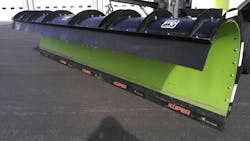Blades for Airside and Landside Snow Removal
Snow removal at an airport involves two distinct operations: removal of snow on the airside (runways, taxiways and ramp areas) and removal of snow on the landside (parking lots, walkways and roadways).
While airport operations staff members may be tasked with both, airside snow removal poses challenges that landside snow removal does not. Two of these challenges are in-pavement lighting and markings.
Kueper Blades helps airports address these challenges. The German company manufactures and sells replaceable cutting edges that bolt onto a snowplow. The Kueper name has long been associated snowplow cutting edges. The company started making snowplow blades in 1967, but only about a decade ago did the company start making snowplow cutting edges specifically for airports. In 2010 Kueper North America was established and airside blade development initially took place here. The first airside blades were the GK 5 rubber blades with a ceramic insert.
The latest airport-specific blade, introduced about three years ago, is the GK5 POLY. “GK” is for Gummi Kueper, the name of the company before it was renamed Kueper in 2007. “Gummi,” in German, means rubber. Kueper is the last name of company founder Walter Kueper. The GK5 POLY is a rubber blade with hardened polyurethane inserts.
Gardi Willis, managing director for Kueper North America, explained the advantage of hardened polyurethane: “We learned over the years that runway in-pavement lights are not all mounted correctly per FAA 139 Advisory Circular. When done properly, the lights should be within 1/16 of an inch above or below grade. Many, we were finding and have found, are often a half inch to 1 inch above grade. Many do not pay attention to this, as it has never been an issue. (People used brooms over lights.)”
When in-pavement lights are not installed correctly, the standard GK 5 can damage the light housings.
Willis continued: “We cannot police light figures so I asked (Kueper) Germany to look for material that would perform in a similar fashion and not damage lights.” The solution they came up with was hardened polyurethane.
On the landside, airport staff might use metal or carbine cutting edges only on the landside. On the airside, he said airports typically will use polyurethane or rubber blades to avoid damaging in-pavement lights or markings and historically, they would run a blade about an inch above the tarmac to avoid premature blade wear during snowplow operations. (A broom would be used to remove the last layer of snow). Running the blade an inch above the tarmac is not necessary with the GK5 POLY (or GK5).
If the pavement is wet and completely covered with slushy snow, a rubberized or polyurethane blade acts like a big squeegee. That, for a rubber or polyurethane blade, might be the perfect storm.
“Snow and slush really reduce the friction coefficient of any snowplow cutting edge,” Willis said.
But what happens when the pavement has dry areas or the snow isn’t so slushy? When the rubber or polyurethane is gripping the surface and there’s nothing to help glide it along, Willis said, “you have this very violent ‘chattering.’”
By incorporating wear materials such as hardened polyurethane inside the rubber, he said that lessens the drag on the blade and increases the wear life of the rubber. The blades are allowed to glide, even over a dry surface because of the wear materials embedded within the rubber. As a result, vibration and noise also are reduced.
“You can actually put a lot more weight on the front plow because the blades won’t wear as quickly and they’re going to do a much better job of cleaning the snow,” Willis said.
Even on an airport runway, he said, “there’s no truly flat surface to clean.” They might seem quite flat to the naked eye, but Willis said there are “various little undulations all throughout that airfield.” A rubber edge he said will conform to those little oddities in the surface of the road and the tarmac.
The GK5 POLY is designed to be used over in-pavement lights and through the flexibility of the edge, enable better cleaning. However, product materials say the airport’s in-pavement light mounting and operation must comply with FAA Advisory Circular 150/5345-46 Specification for Runway and Taxiway Light Fixtures 03/02/2016 in order to use Kueper plow blades.
“If the lights are mounted properly, there should be no issues with our cutting edges,” Willis said.
But because he has found many lights are not mounted properly and because no two airports are alike (their equipment and surfaces are different), Willis said Kueper asks each airport what issues they’re dealing with and how Kueper can help, then they test the blades over the in-pavement lighting at the airport.
“No two in-pavement lights are the same – mounted the same or adjusted the same, they all seem to be different,” he said. Ideally, he said a blade will be tested for a whole season, then use of the blade can be expanded.
GK5 POLY blades are 16 or 17 pounds per foot and they come in 3- or 4-foot sections. A landside blade might be 12 feet wide, while an airside blade might be 24 feet. Whether they’re installed on trucks on the landside or specialty trucks and equipment on the airfield side, the blades, which have a steel fastening neck (to keep the blade from flipping under the plow) are mounted with a “Standard Highway Punch” (bolt holes 12 inches on center).
“Once you’ve mounted them, you never adjust them,” Willis said. “You simply run them til they wear out.”
How long will a blade last?
“It all depends on how far down they’ll actually run the blade,” he said. That’s one factor.
Other factors he said include the ferocity of the winter and the geographic location of the airport. An airport in North Carolina, for example, that maintains snow removal equipment might not need to change or adjust their blades for several years. Both the number of storms and the type of storm make a difference. Ice storms can wear the blades quickly.
“There are just a lot of factors that go into blade wear (and the need to change blades),” Willis said. “It may seem uncomplicated, but it really isn’t.”
From the mechanic’s standpoint, he said, “no one enjoys changing or adjusting snowplow cutting edges during a storm. It’s a dirty job. There are a lot of safety issues associated with it and most importantly, you’re taking that really special piece of equipment – that needs to be out doing its job – out of service.”
But, he said, “If you use blades such as ours, you’re keeping the equipment out longer, operating during the storm, where it should be, doing its job.” And, he said, downtime and associated maintenance costs are reduced.
While Kueper blades cost more upfront, he said, “They are sustainable in the fact that they last so much longer, they clean so much better, and they reduce the overall maintenance costs associated with normal blade changes.”
Snowplow cutting edges may seem like a small part of that whole winter maintenance program, but, as Willis said, “You know they are a pretty vital part of it at the same time because it’s how the snowplow does its job.”
Product: GK5 POLY Snowplow blade
Manufacturer: Kueper Blades
What does it do? Removes snow
What it’s made of? Rubber with hardened polyurethane inserts
Width: Standard sections are 3 and 4 feet.
Height: About 7.5 inches.
Weight: About 16.5 lbs.
Where’s it used? Airside or landside
Why is it beneficial? Protects surfaces including in-pavement lights and markings
What’s most impressive? Rubber blade doesn’t “jump” when used on dry surfaces
About the Author
Rebecca Kanable
Assistant Editor
Rebecca Kanable, a veteran journalist, worked with Endeavor Business Media's aviation group from 2021 to 2024 as assistant editor of Airport Business, AMT and Ground Support Worldwide. She previously worked for various publications, including trade magazines and newspapers.

